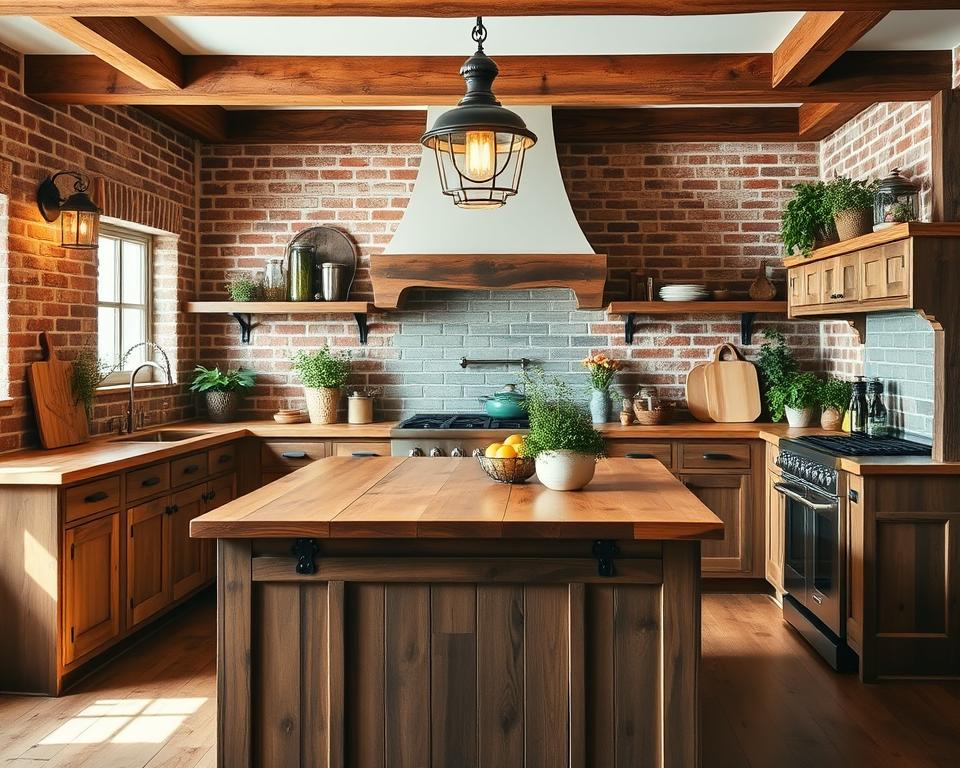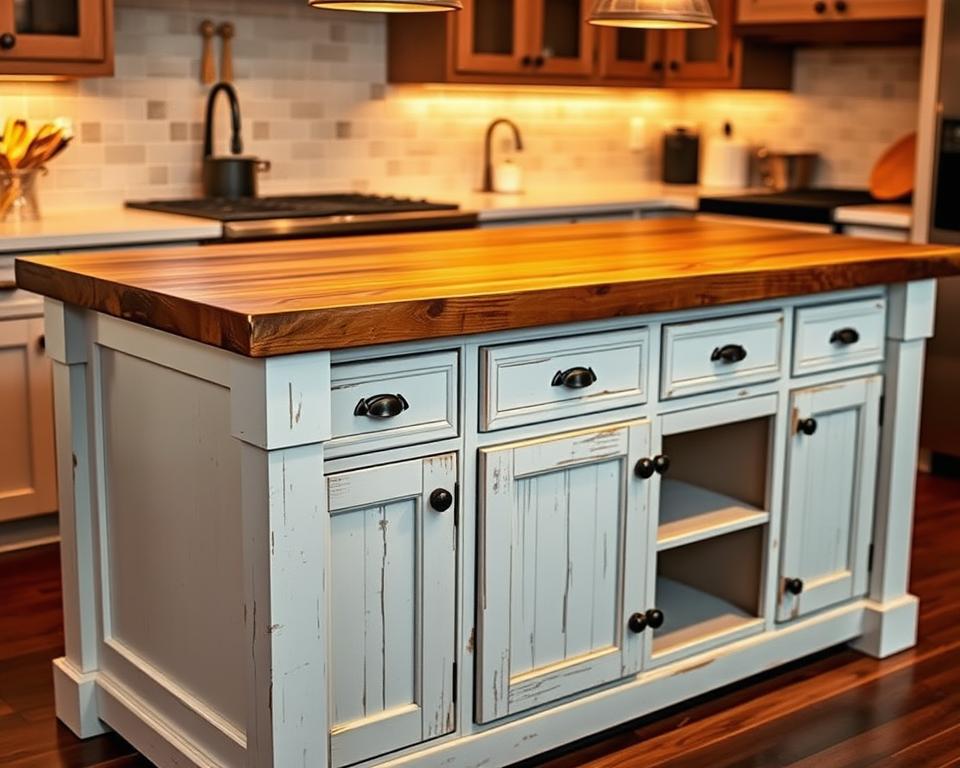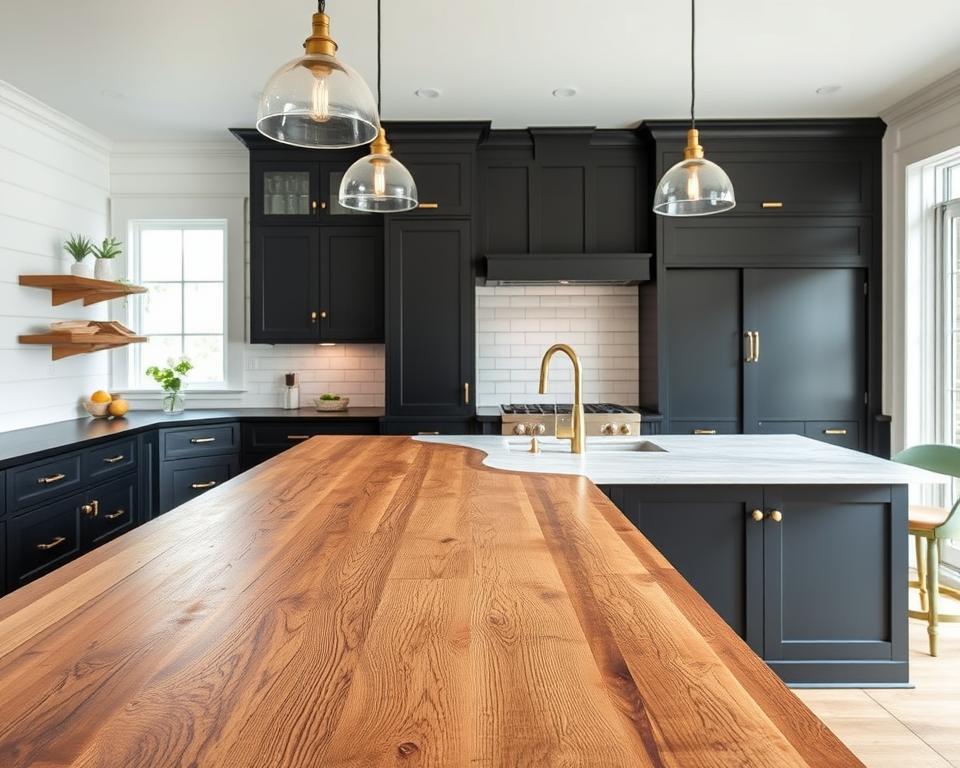Farmhouse kitchen islands merge rustic charm with modern functionality, becoming a key element in today’s kitchen designs. They offer versatility, from open shelving to built-in storage, while retaining the timeless farmhouse look. Options like reclaimed wood or painted cabinets can turn small areas into cozy, functional spaces.
Brands like Wayfair and Crate & Barrel provide both custom and ready-to-assemble kitchen island designs, catering to various budgets. A 3×6.5-foot island with a 36-inch height is suitable for most layouts. The 24-inch-wide seating ensures comfort. Open-bottom styles save space, while closed designs conceal clutter. Details such as limestone accents and vintage decor enhance the rustic charm.
Key Takeaways
- Ideal width for traffic around islands: 4–4.5 feet.
- 70% of farmhouse designs use multiple wood tones to add warmth.
- 42–48 inches of clearance around islands improves accessibility.
- Reclaimed wood and painted cabinets are top material choices.
- Adding power outlets or cutting boards boosts functionality.
Understanding the Appeal of Farmhouse Kitchen Islands
Farmhouse kitchen islands blend rustic charm with modern functionality, becoming a staple in today’s kitchens. They combine reclaimed wood, antique touches, and open layouts. This creates spaces that are both inviting and practical. Whether serving as a small prep area or a large kitchen islands for hosting, they meet various home needs.
What Makes Farmhouse Style Unique?
The rustic essence of this style is what sets it apart. Key elements include:
- Reclaimed wood: Provides texture and an eco-friendly edge
- Shiplap accents: Adds to the farmhouse charm with wall treatments
- Weathered finishes: Distressed paint or wood brings vintage appeal
Benefits of Adding a Kitchen Island
These fixtures bring several practical advantages:
- Extra counter space for meal prep and appliances
- Built-in seating for casual meals or projects
- Storage solutions like hidden drawers and shelves
Prices vary from $100 for prefab options to $10,000 for custom designs. Large kitchen islands typically cost between $5,000 and $10,000. This depends on materials such as soapstone countertops or handcrafted cabinetry.
| Style | Average Cost | Cost Range |
|---|---|---|
| Galley | $4,250 | $1,500–$7,000 |
| Rectangle | $5,750 | $1,500–$10,000 |
| L-Shaped | $7,000 | $2,000–$12,000 |
| U-Shaped | $9,000 | $3,000–$15,000 |
Enhancing Social Interaction in the Kitchen
These islands become central gathering points for family and friends. They often feature:
- Seating with 28–30 inches per person
- Open shelves for displaying decor and snacks
- Lighting fixtures that create inviting atmospheres
Designers recommend pairing with kitchen islands 36–42 inches wide for optimal use. Ensure at least 42 inches of space around for safety and usability.
Key Elements of Farmhouse Kitchen Design
Creating a farmhouse kitchen island begins with materials and colors that bring warmth and authenticity. Rustic textures and neutral tones are key, blending function with timeless charm. Whether you’re planning custom kitchen islands or updating kitchen island designs, these elements ensure a cohesive look.
Rustic Materials for Authenticity
Reclaimed wood and natural stone are at the heart of farmhouse style. Butcher block countertops, like those from Dura Supreme, bring durability and rustic texture. Shiplap walls or open shelving showcase organic imperfections.
Over 55% of homeowners opt for natural wood accents, such as Quarter-Sawn White Oak, for their lasting appeal. Industrial touches like metal legs or iron hardware add contrast without dominating the space.
Choosing the Right Color Palette
Neutral foundations like whites, soft grays, and muted greens create a light-filled backdrop. A kitchen island in dark walnut or navy can anchor the room. Pastels like blush pink or sage green add subtle vibrancy.
“Mixing matte black hardware with creamy cabinetry balances modernity and tradition,” says interior designer Sarah Lin. Stick to 2-3 primary hues, then layer in woven textiles or vintage pottery for depth.
- Top materials: Reclaimed wood, soapstone, and metal accents
- Signature colors: White, soft blue, and muted green with earthy contrasts
- Key trends: Open shelving, apron sinks, and farmhouse-inspired lighting
Pairing these elements with functional pieces like the BEKVÄM spice rack or RÅSKOG utility cart maintains practicality without sacrificing style. Whether building from scratch or updating existing layouts, focusing on these details ensures a space that’s both inviting and enduring.
Space-Saving Ideas for Smaller Kitchens
Maximizing farmhouse style in compact kitchens begins with smart choices. Small kitchen islands and portable kitchen islands bring flexibility and function without overwhelming limited space. These ideas allow you to enjoy farmhouse charm in any kitchen size.
Multi-Functional Furniture Solutions
Choose portable kitchen islands on wheels, like IKEA’s compact models, for easy repositioning. Fold-down leaves or dual-height tops enable a switch from meal prep to seating. Rolling carts serve as dining areas or serving stations.
- Mobile islands under 4ft wide fit narrow layouts
- Hidden shelves inside island bases store pots and pans
- Convertable tabletops flip to reveal extra counter space
Incorporating Built-In Storage
Vertical storage in small kitchen islands adds hidden compartments. Pull-out drawers and open shelving keep essentials visible yet tidy. Here’s how to maximize every inch:
| Solution | Benefit |
|---|---|
| Vertical Shelves | Adds 30% more storage vertically |
| Pull-out Drawers | Stores spices and utensils discreetly |
| Hidden Appliances | Integrated sinks or mini fridges save counter space |
Pair with open shelving to maintain light flow. Opt for slim profiles and minimalist designs to avoid clutter.
Selecting the Ideal Size and Shape for Your Island
Choosing the right size and shape for your farmhouse kitchen island begins with assessing your space. Whether your kitchen is cozy or open, the island must fit seamlessly. Proper measurements are crucial to ensure it functions as a central hub. Let’s dive into how to select the perfect fit for your kitchen.
A well-designed kitchen island must balance aesthetics with functionality. Rectangular and square shapes each bring unique benefits. Here’s how to choose the best one for your space:
Rectangular vs. Square Islands
- Rectangular islands offer extended prep space, ideal for large gatherings or multitasking.
- Square islands provide a compact area for socializing, perfect for smaller kitchens.
Standard Dimensions for Kitchen Islands
Dimensions vary based on your kitchen’s size. Use these ranges as a starting point:
| Kitchen Size | Width Range (inches) | Length Range (inches) |
|---|---|---|
| Small | 24″–36″ | 36″–60″ |
| Medium | 36″–48″ | 60″–84″ |
| Large | 48″–72″ | 84″–108″ |
| Extra-Large | 72″+ | 108″+ |
Height is also important. Work surfaces should be 36″–38″ high, while seating areas should be 28″–30″. Bar heights, ranging from 42″–45″, are suitable for large kitchen islands in open layouts. Always ensure 42″–48″ clearance around the island for easy movement.
Popular Farmhouse Kitchen Island Styles
Today’s kitchen island designs blend tradition with innovation, offering a wide range of styles. Whether you prefer cozy classics or modern updates, farmhouse designs cater to all tastes. Let’s dive into how to combine heritage elements with contemporary touches.
“Wood tones are the heartbeat of farmhouse style,” says designer Jeremiah Brent. He notes how wood hues add warmth without overwhelming small spaces. His design features a dark wood island alongside honey-toned ceiling beams for a balanced look.
Classic Wooden Designs
Traditional farmhouse islands combine modern kitchen islands with rustic charm. Key features include:
- Apron-front sinks and beadboard panels
- Distressed oak or pine finishes
- Turned legs or X-brace supports
Pro tip: Mixing wood tones adds depth, with 60% of homeowners pairing hickory with reclaimed pine.
Modern Farmhouse Aesthetics
Modern designs merge rustic warmth with sleek lines. 30% of kitchens blend wood with metals, while 45% use soft gray or sage paint to complement wood tones. Trends like open shelving (35%) and waterfall edges (30%) enhance visual appeal without sacrificing functionality.
Custom elements like repurposed tables (15%) or visible brush strokes (12%) make spaces feel both lived-in and updated. Whether you lean towards classic or contemporary, farmhouse design evolves, never staying the same.
Essential Features to Consider
When designing custom kitchen islands, it’s crucial to find a balance between aesthetics and functionality. Islands that blend style with practicality create welcoming and efficient spaces. By choosing the right appliances and seating, islands become central points for cooking and socializing.
Sinks and Appliances
Integrating elements like prep sinks or undercounter fridges boosts kitchen efficiency. Farmhouse apron sinks combine rustic appeal with practicality, while Neolith countertops endure daily wear and tear. It’s important to plan plumbing and electrical layouts carefully, ensuring at least 48 inches between the island and nearby appliances for safe movement. Options like microwave drawers and beverage chillers, hidden in cabinetry, enhance the island’s appearance.
- Install undercounter appliances for a clutter-free surface
- Allow 48 inches between the island and adjacent appliances
- Choose durable materials like quartz or Nano Glass
Seating Arrangements for Comfort
Designing seating areas should focus on both comfort and ease of movement. Bar stools are ideal for 36-inch-high counters, while 42-inch surfaces are better for prep tasks. Ensure 24 inches of space between each seat and 16–18 inches of overhang for knee room. Two-tier islands offer both dining and task areas, enhancing versatility. Most designs can comfortably seat 3–4 adults, but avoid overcrowding by adhering to these guidelines.
- 36-inch counter height for seating areas
- 24-inch spacing between each chair or stool
- 16–18-inch overhang for seating comfort
With careful planning, your island can support both daily routines and social gatherings. From heated countertops to pet-feeding stations, kitchen island ideas can be customized to fit your lifestyle while retaining farmhouse charm.
Enhancing Functionality with Accessories
Transform your kitchen islands into multifunctional hubs with thoughtful accessories. Strategic lighting and open storage can elevate both style and practicality. For instance, pendant lights add warmth while meeting the National Kitchen & Bath Association’s 36-inch workspace clearance guideline. Open shelving, like designer Kate Abt’s approach, keeps essentials visible without sacrificing charm.
Adding Functional Lighting
Choose lighting that blends form and function. Pendant lights or rustic chandeliers cast ambient light, while recessed options keep the space uncluttered. Follow these guidelines:
- Hang pendant lights 30-36 inches above the counter
- Pair fixtures with 500-700 lumens for task lighting
- Layer lighting with under-cabinet strips for evening prep
| Lighting Type | Pros | Cons |
|---|---|---|
| Pendant Lights | Adds visual interest | Requires precise hanging measurements |
| Recessed Lighting | Modern minimalism | Limited design customization |
| Chandeliers | Vintage charm | May overwhelm small kitchen islands |
Incorporating Open Shelving
Swap closed cabinets for open storage to align with farmhouse aesthetics. Balance decorative jars, cookbooks, and utensils to avoid clutter. Pro tip: Use baskets or tiered shelves to organize small appliances or spices. According to design experts, open shelving increases kitchen island storage efficiency by up to 30%.
“Open shelving creates a relaxed vibe, making your kitchen feel like a gathering spot.”
Pair these ideas with durable materials like butcher block or farmhouse-style ceramics. Lighting and storage upgrades turn kitchen islands into focal points that enhance both daily tasks and social moments. Let these kitchen island ideas guide your transformation today.
Mixing and Matching Colors and Textures
Adding depth to kitchen island designs begins with bold material pairings. The team at Pfeffer Torode demonstrated this in a Nashville kitchen. They paired an oak island with shiplap walls, creating a rustic-modern contrast. Modern kitchen islands flourish when textures like marble countertops meet weathered wood bases. Think of smooth quartz paired with reclaimed barn wood for a layered look.
Combining Wood, Metal, and Stone
- Pair modern kitchen islands with matte-black faucet fixtures against cream-colored cabinetry for a stark contrast.
- Try copper hardware with matte black appliances to blend rustic and industrial elements.
- Layer natural stone backsplashes with matte-finished cabinetry for a grounded yet stylish base.
Tips for a Cohesive Look
Adhere to the 60-30-10 rule: a neutral tone should dominate (60%), a secondary color anchor accents (30%), and a bold hue add drama (10%). For instance, Sheldon Harte’s moody kitchen uses dark wood for 60% of the palette. Copper accents (30%) and a single green tile (10%) complete the look.
Pair durable quartz near stoves with softer wood surfaces for food prep. As Naked Kitchens advises, mixing metals like brushed nickel and copper works best when one dominates. Balance high-maintenance materials (marble, marble) with low-maintenance options (laminate, stainless steel) to simplify upkeep.
Remember: a mix of matte and glossy finishes adds visual weight without overwhelming the space. Let a marble island (modern kitchen islands) contrast with matte-black cabinetry for timeless appeal. By balancing trends like deep green tones with neutral bases, your design stays stylish yet durable.
Incorporating Your Personal Style
Every kitchen island has a story to tell. Transform your custom kitchen islands into a mirror of your lifestyle with personal touches. Whether you adore vintage treasures or modern flair, here’s how to make your space uniquely yours.
Customizing Your Kitchen Island Design
Begin with custom kitchen islands designed to meet your specific needs. Incorporate unique features such as:
- Hidden wine racks or pet feeding stations
- Edges with hand-carved details or rounded corners
- Custom hardware in finishes like brushed nickel or reclaimed wood
Work with local carpenters to merge farmhouse charm with functionality. Consider a rolling butcher block section for holidays or a chalkboard surface for meal planning.
Ideas for Unique Accents and Décor
Add layers that reflect your interests. Try:
- Vintage breadboards or antique signage for shelves
- Seasonal collections—think mason jars in spring or copper pots in fall
- Heirloom items displayed on open shelves
“Your kitchen island is a canvas—mix antiques with modern touches to create a space that feels alive.” – farmhouse design experts
Rotate small decor pieces like seasonal flowers or holiday-themed trivets to keep the look fresh. Choose storage baskets labeled with chalkboard tags to conceal clutter. With the right kitchen island ideas, even a simple design can become a heartfelt focal point.
Maintenance Tips for Your Kitchen Island
Keeping your farmhouse kitchen island in top shape begins with effective care routines. Whether it’s made of wood, stone, or is portable, regular maintenance ensures it remains both functional and aesthetically pleasing. Follow these simple steps to safeguard your investment.
- Use mineral oil every 1–3 months for wood kitchen islands to keep surfaces smooth.
- Wipe spills immediately—acidic liquids like vinegar or citrus juice can etch wood.
- Place coasters under glasses and cutting boards under knives to avoid scratches.
“Regular care doubles the lifespan of wooden kitchen islands,” says Highland Manor Wood Products, a leader in durable kitchen furniture.
Stone kitchen islands require gentle care. Avoid harsh cleaners, and reseal granite every 1–2 years. Marble needs gentle, pH-neutral cleaners. Always use trivets under hot pans to prevent heat damage. Metal islands should be wiped with a soft cloth and non-abrasive polish to prevent tarnishing.
Inspect seams and corners yearly for cracks or wear. Light scratches on wood can be fixed with sandpaper and re-oiling. Severe damage? Call a professional refinisher. Remember: 80% of wood damage comes from delayed spill cleanup, so act fast!
Portable kitchen islands offer flexibility but still need care. Store them in dry areas and inspect casters yearly for smooth mobility. With these steps, your kitchen island can last decades—perfect for that timeless farmhouse charm.
Inspiring Examples of Farmhouse Kitchen Islands
Real-life transformations show farmhouse kitchen islands can turn visions into reality. They blend rustic warmth with modern practicality, fitting both compact urban kitchens and large open spaces. Whether you’re working with modern farmhouse kitchens, small spaces benefit from clever small kitchen islands with built-in seating or storage. A 4×8-foot island balances style and function, while 45% of designs now add dual purposes like dining and prep zones.
Case Studies in Rustic Elegance
Homeowners report higher satisfaction with farmhouse islands featuring shiplap or reclaimed wood—elements 40% of modern kitchens now include. The 10-20% resale value boost comes from thoughtful details like open shelving or black window accents, which 25% more buyers now seek. Even compact layouts gain charm through sleek waterfall edges or vintage sinks, proving kitchen island ideas work in any space. Case studies show 78% of renovators blend rustic and modern styles, creating spaces that feel both timeless and fresh.
Top Brands Shaping Trends
Leading brands like Pottery Barn and Ballard Designs offer pre-made islands with distressed finishes, while Wayfair carries petite options for tight spaces. High-end options from Restoration Hardware pair marble countertops with iron legs, showcasing industrial-farmhouse fusion. DIY enthusiasts can follow tutorials using reclaimed wood, a staple in 65% of current farmhouse projects. With 33+ design examples online, there’s a solution for every budget and taste.
From seating nooks to butler sinks, these islands create hubs of activity. With 30% faster home sales linked to farmhouse kitchens, now’s the time to mix materials like stone and wood. Explore these ideas and turn your kitchen into a space that’s both inviting and functional—where every detail tells a story.
FAQ
What are the typical features of a farmhouse kitchen island?
How can a kitchen island enhance social interaction?
What are the best materials for a farmhouse kitchen island?
Can farmhouse kitchen islands be used in small kitchens?
What size and shape should my kitchen island be?
How can I incorporate personal style into my kitchen island?
What lighting options complement farmhouse kitchen islands?
How do I maintain my farmhouse kitchen island?

Tina Moore is a writer at TrendGaping, dedicated to farmhouse decor and rustic minimalism. With a love for natural textures and vintage charm, she explores topics like distressed wood finishes, cozy interiors, and functional yet stylish design. Her goal is to help readers create warm, inviting spaces that reflect the beauty of country living.



